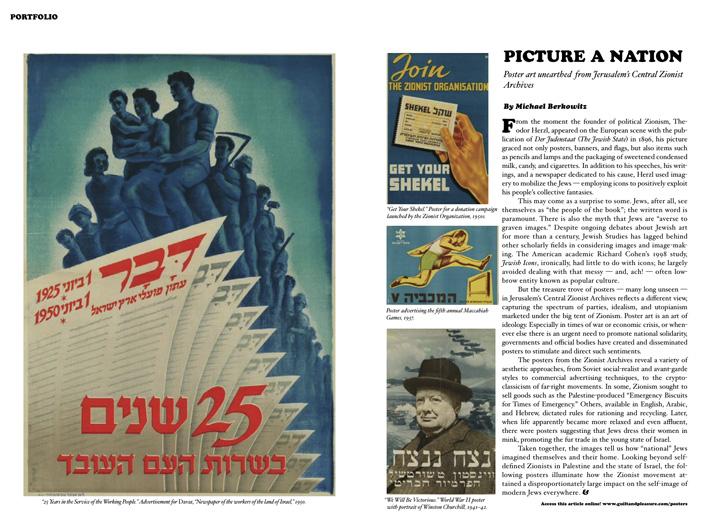Click here to download a PDF of the article
BY MICHAEL BERKOWITZ
From the moment the founder of political Zionism, Theodor Herzl, appeared on the European scene with the publication of Der Judenstaat (The Jewish State) in 1896, his picture graced not only posters, banners, and flags, but also items such as pencils and lamps and the packaging of sweetened condensed milk, candy, and cigarettes. In addition to his speeches, his writings, and a newspaper dedicated to his cause, Herzl used imagery to mobilize the Jews — employing icons to positively exploit his people’s collective fantasies.
This may come as a surprise to some. Jews, after all, see themselves as “the people of the book”; the written word is paramount. There is also the myth that Jews are “averse to graven images.” Despite ongoing debates about Jewish art for more than a century, Jewish Studies has lagged behind other scholarly fields in considering images and image-making. The American academic Richard Cohen’s 1998 study, Jewish Icons, ironically, had little to do with icons; he largely avoided dealing with that messy — and, ach! — often lowbrow entity known as popular culture.
But the treasure trove of posters — many long unseen — in Jerusalem’s Central Zionist Archives reflects a different view, capturing the spectrum of parties, idealism, and utopianism marketed under the big tent of Zionism. Poster art is an art of ideology. Especially in times of war or economic crisis, or whenever else there is an urgent need to promote national solidarity, governments and official bodies have created and disseminated posters to stimulate and direct such sentiments.
The posters from the Zionist Archives reveal a variety of aesthetic approaches, from Soviet social-realist and avant-garde styles to commercial advertising techniques, to the crypto-classicism of far-right movements. In some, Zionism sought to sell goods such as the Palestine-produced “Emergency Biscuits for Times of Emergency.” Others, available in English, Arabic, and Hebrew, dictated rules for rationing and recycling. Later, when life apparently became more relaxed and even affluent, there were posters suggesting that Jews dress their women in mink, promoting the fur trade in the young state of Israel.
Taken together, the images tell us how “national” Jews imagined themselves and their home. Looking beyond self-defined Zionists in Palestine and the state of Israel, the following posters illuminate how the Zionist movement attained a disproportionately large impact on the self-image of modern Jews everywhere.

